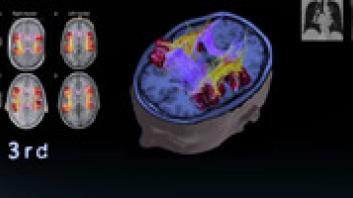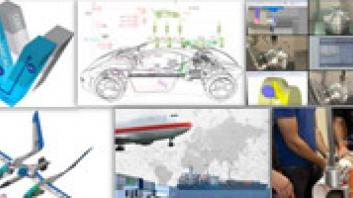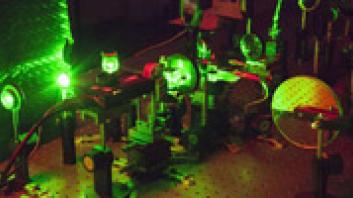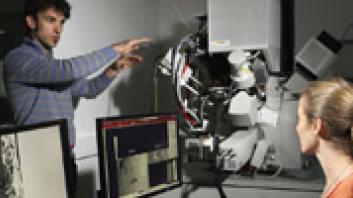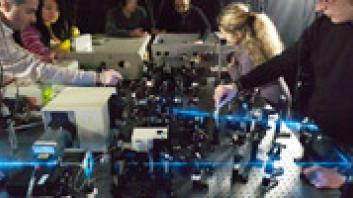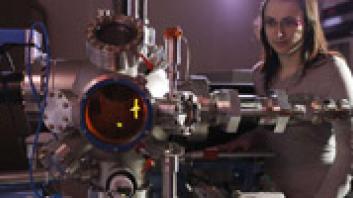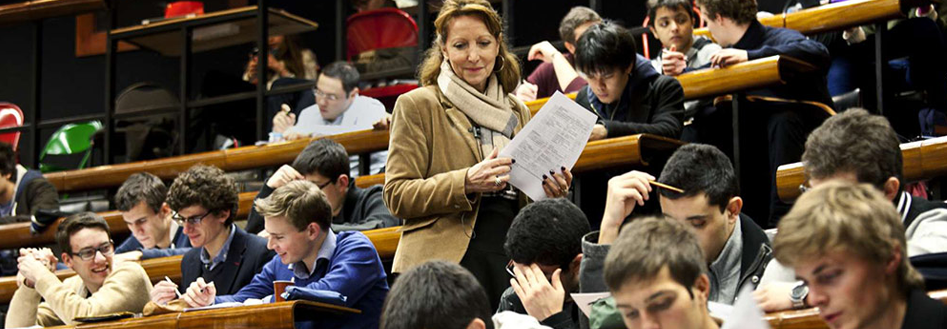Scientific publications
Laboratories
Growing research partnerships
The CentraleSupélec Research Centre aims to bring innovative solutions to the major challenges of society, through the advancement of knowledge. Its close relationship to the business community lends itself more easily to the forging of solid and varied partnerships, with emphasis on industry relations.
Collaborations between CentraleSupélec's research and businesses take different forms. We provide industrialists access to researchers of the highest academic and scientific level. The expenses related to these collaborations are eligible for the Research Tax Credit.
Doctoral thesis
The research collaboration between a business or industrial organisation and CentraleSupélec can be carried out within the framework of a doctoral thesis of 3 years: The doctoral candidate can either be an employee of the company (CIFRE, an industrial convention for training through research, or a funded doctoral candidate of the school.
Scientific advice, study, expertise
The CentraleSupélec Research Center also offers:
- outsourced research contracts, with a duration varying from several days to several months
- assistance and advice with defining a scientific program
- the benefits of scientific equipment of the highest order
Collaborative projects
The school’s laboratories also participate in collaborative research projects supported by external public funding aimed at joint academic/industry consortia, such as projects for the Agence Nationale de la Recherche and the European Union.
Framework agreements
For up to 4 years - the framework agreement is based on a defined scientific program and specifies the collaboration and the respective contributions of each partner. A steering committee ensures compliance with the initial guidelines and evaluates the progress of the work.
Mixed teams
The Research Center has also set up joint teams with the industrial community.
For example:
RISEGrid: A research institute dedicated to intelligent electricity distribution networks in partnership with EDF. Established in 2012 by EDF and CentraleSupélec, RISEGRID (Research Institute for Smarter Electric Grids), a research institute whose objective is to prepare and support the development of intelligent electrical distribution networks known as Smarts Grids. This modernization of the network will contribute to the energy transition by enabling electricity to be supplied even more efficiently.
Chairs: long-term partnerships for mutual benefit
In addition to a growing number of research contracts with a large network of partner companies, CentraleSupélec has developed chairs of companies and collaborations with the industrial world of 5 to 10 years for the advancement of knowledge on future research agendas.
CentraleSupélec now has 20 university-corporate partnerships
1 - Artificial intelligence applied to fraud detection in payments and trading
Lusis is the publisher of TANGO, a high-performance transactional platform for payment systems and market finance. Based on this platform, Lusis creates complete payment systems, including fraud detection, as well as extremely rich and complex "front to back" trading platforms on which more than 5 billion dollars are traded every day, half of which is on Forex and the other half on Indices and Commodities. Lusis and CentraleSupélec have joined forces to create a research chair to strengthen their collaboration in the field of artificial intelligence applied to banking.
Launched in 2020, the Lusis - CentraleSupélec Artificial Intelligence Chair is developing two main research areas
- the detection of bank card payment fraud
- automated trading
- Chairholder: Fabrice Popineau of the Interdisciplinary Digital Sciences Laboratory
- Partner: Lusis
2 - Chair of Biotechnology
Renewed in 2020, CentraleSupélec's Biotechnology Chair is currently co-finaReenced by the Marne Department, Greater Reims, the Grand Est Region, and the European Union with the European Regional Development Fund FEDER Champagne Ardenne 2014-2020.
The Biotechnology Chair is based at the European Center for Biotechnology and Bioeconomy (CEBB), supported by these four authorities.
Backed by the Process and Materials Engineering Laboratory at Gif-sur-Yvette, the Chair ensures a close link between its parent institution, CentraleSupélec, and the region's economic and academic players, by putting its R&D expertise to work on innovative projects. CentraleSupélec, with its training of high-level general engineers, has strong expertise in Modeling applied to (bio)process engineering and (bio)materials. It is particularly active in three fields of application
- Characterization and conversion of lignocellulosics
- Bioprocessing
- Separative techniques.
In addition to experimental approaches, the three thematic axes of the Chair are based on a base of skills in Modeling, simulation & visualization, more particularly oriented towards the Modeling of living organisms and the transition to industrial scale.
Partners :
- Chairholder: Patrick PERRE from the LGPM laboratory
- Partners: Grand Reims, Marne department, Grand Est region, European Union
3 - FlexTech Chair
The FlexTech Chair is a research and teaching chair dedicated to human-systems integration in complex systems with increasing autonomy. It is based on the innovative approach of Human-Centered Design (HCD), which places people and organizations at the heart of industrial and societal issues. This method has proven itself over the past twenty years in high-tech fields (especially aerospace), requiring a flexible approach and development on a scientific and technical level.
Conceived and created by Professor Guy André Boy with the Industrial Engineering laboratory and the ESTIA engineering school, this chair is designed to meet the expectations of industrialists and local authorities, faced with the increasing complexity of the products and services they implement: digitization of complex remote operations, management of fleets of robots, management of vehicles with varying degrees of autonomy, training of personnel on simulation systems including real and virtual systems, use of digital twins to help diagnose failures and the progressive integration of knowledge from feedback, etc.
- Titleholder: Guy André BOY from the LGI laboratory
- Partners: ESTIA, DGA, C-S Group
4 - Artificial intelligence dedicated to employment with Randstad
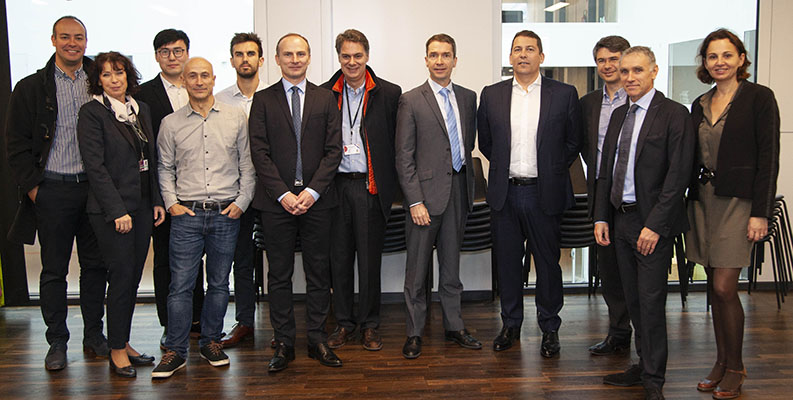
This academic and scientific partnership is part of a resolutely disruptive and ethical approach to the recruitment process. As in many other fields and industries, artificial intelligence, its advances and opportunities, and the wealth and wealth of employment data available, offer many opportunities for improved recruitment and human resources, both from the perspective of the recruiter and the candidate.
A more complete and accurate representation of the job applicant from a diverse and heterogeneous dataset (CV, Historical, Navigational, Professional Social Network Profile, Video Interview, Consulting Conversations, Chatbots...). This multitude of data involves building new methods of data collection and annotation to better understand the candidates and their potential.
The processing of new recruitment tools such as audio-video interview, through analysis of the candidate’s emotions and personality. These elements can be an important added value in advising candidates as recruiters focus on soft skills.
Designing and optimizing algorithms in the recruitment process (matching algorithms between a candidate and an offer, recommendation algorithm or techniques to search for candidates or offers) with constant attention to the concepts of transparency, trust and interpretability of algorithms. One of the additional issues is algorithmic non-discrimination. The idea is to explore technological and human means to ensure that a candidate is assessed solely on the basis of his or her skills and know-how, without subjectively bias in pre-selection.
- Titleholder: Céline Hudelot (MICS laboratory)
- Partner: Randstad
5 - RTE Chair
RTE and CentraleSupélec have signed a new 5-year academic partnership. This "Digital Transformation of Electrical Networks Chair" aims to study the potential of digital technologies for managing electrical systems.
For several years now, RTE has been studying the potential of digital technologies for power system management. Building on its close scientific and educational relationship with CentraleSupélec, RTE wanted to strengthen this collaboration and establish this new long-term partnership in order to accelerate its innovation processes and benefit from the scientific expertise of leading research teams with whom to interact in the field of engineering sciences.
It is in this context that a five-year research chair has been signed. The development of digital technologies represents a formidable lever that transforms the management, development, and operation of the electrical system. The integration of these technologies into the electricity transmission network will enable RTE to make the most of existing infrastructures and to propose new ways of carrying out its missions in the context of the energy transition.
The design of the communication network that will be deployed to observe and control the electricity transmission network will require multidisciplinary challenges specific to energy networks. This Chair will involve several CentraleSupélec laboratories and teams recognized in France and internationally and will focus on four key disciplines: Communications, Computer Science, Control and Decision, and Electrical Engineering.
Through its curricula and laboratories, CentraleSupélec has been one of the leading players in developing this vision, which has become essential today: the convergence of the fields of Energy and Communications. Thanks to an active support policy, RTE is creating a stable environment of partners and experts whose complementary skills enable the development of new concepts and solutions for a network combining electricity and digital technology.
- Titlehorlder: Sorin Olaru (L2S laboratory)
- Partner: RTE
6 - 5G Chair - TCL
As mobile data usage and quantity grow at an unprecedented rate (18 times in 5 years), networks must evolve rapidly and radically to meet demand. The 5th Generation "5G" standard will have to meet very ambitious objectives such as throughput (up to 20Gb/s), low latency, reduced energy consumption, and a massive number of connected objects per antenna. These objectives are partly contradictory, and it is from this contradiction that opportunities arise to apply new scientific solutions, developed by the 5G Chair and involving researchers from CentraleSupélec and TCL Communication laboratories.
The Research Chair aims to bring together players in mobile communications to create a significant breakthrough in 5G.
- Chairholder: Mohamad Assaad (Signals and Systems Laboratory L2S).
- Partners: TCL
7 - Photonics Chair
Aware that the exploitation of light is both a societal issue and a vector of economic development, CentraleSupélec has promoted the creation of the Photonics Chair on its Metz campus. This Chair is unique in France because of its structuring project, which aims to develop scientific excellence in optical information processing, to develop innovation and technology transfer to companies, and to develop training and education on the importance of light and optical technologies. The Photonics Chair was created on the initiative of CentraleSupélec and its partners.
Understanding and developing photonics also means perceiving the importance that artists, writers and philosophers have given to light, and better understanding the central place it occupies at the frontier of several scientific disciplines such as mathematics, physics, biology or chemistry. Photonics is also widely present among the key technological challenges that will be faced by our society in the next ten years.
Understanding and developing photonics also means perceiving the importance that artists, writers and philosophers have given to light, and better understanding the central place it occupies at the frontier of several scientific disciplines such as mathematics, physics, biology or chemistry. Photonics is also widely present among the key technological challenges that will be faced by our society in the next ten years.
- Titleholder: Marc Sciamanna
- Partners: GDI Simulation, European Union, Grand Reims, Moselle Department, Grand Est Region, Metz Métropole, CentraleSupélec Foundation
8 - Research Chair "Security of embedded systems in the context of the Internet of Things
The research focuses in particular on intrusion detection and privacy. With this chair, the CIDRE team reinforces its competencies in embedded systems security and the Internet of Things (IoT) through research activities of international level but permanently inscribed in societal concerns aiming at an industrial valorization through bilateral partnerships and national and international cooperative projects.
- Titleholder: Sam Thomas - CIDRE team
- Partners: INRIA, Brittany Region
9 - Supply Chain Management Chair with AIR LIQUIDE, L'OREAL, and SAFRAN
Three research axes have been identified by the partners of the Supply Chain Chair. They are in line with the work that has been carried out since the creation of the chair in 2008.
- Flexibility management
The current industrial world is characterized by an increasing level of uncertainty with more and more personalized customer expectations and the increasingly rapid change of markets.
To face these uncertainties, it is necessary, on the one hand, to reduce their amplitudes, using efficient forecasting methods and processes, and on the other hand to implement flexibility in order to face the residual uncertainties.
- Environmental impact of the Supply Chain and sustainable development
Sustainable development has become a significant concern for public authorities and consumers.
- Performance measurement and animation
This theme is interesting in the systems of measurement and animation of the performance of the Supply Chain of industrial or distribution companies. It covers two interdependent sub-themes:
- The problem of the measurement of the performance: specification of the system of performance indicators allowing to evaluate effectively and globally the various activities and processes of the Supply Chain,
- The problem of the animation of the performance: specification of the processes of animation of performance, the implied actors and their respective roles, allowing from the system of indicators set up to pilot the activities and the processes of the Supply Chain to know their level of performance and to identify the levers of improvement of these performances and the associated stakes.
- Titleholder: Yves DALLERY (LGI laboratory)
- Partners : Air Liquide, L'Oréal, Safran
10 - Chair in Risk and Resilience of Complex Systems
The Chair aims to advance, through research, the discipline of modeling complex systems, analyzing the risks to which they are subjected, and optimizing their resilience, with a dual objective of scientific excellence and transfer.
A complex system cannot be thought of in isolation without considering its environment and the other - often complex - systems with which it interacts. We then speak of systems of systems. In the context of the RRSC Chair, a complex system corresponds to a company, an operator, or an industrial partner. A system of systems is a complex system that involves several operators or industrial partners.
- Chairholder: Anne BARROS (LGI laboratory)
- Partners: EDF, SNCF, ORANGE, INSTITUT DE FRANCE-ACADEMIE DES SCIENCES, FONDATION CENTRALESUPELEC
11 - Oxy-Combustion Research Institute
The Air Liquide Oxy-Combustion Chair partners are developing research activities in the field of combustion optimization and heat transfer.
The research program aims to improve knowledge of high-pressure oxy-combustion of fuels of different types whose gases are diluted by carbon dioxide or water vapor around an experimental platform with significant optical access.
It brings together researchers specializing in oxy-combustion experiments and diagnostics, heat transfers, particularly radiation, and the simulation of interactions between combustion, turbulence, and heat transfers.
- Titleholder: Clément Mirat from the EM2C laboratory
- Partners : Air Liquide, CNRS
- Institution : ANR
12 - Armand Peugeot Chair: Hybrid Technologies and the Economics of Electromobility with STELLANTIS and ESSEC
Subject: Hybrid technologies and the economics of electromobility
Assumptions about the evolution of mobility over the next twenty years and the place of hybrid vehicles in the market are often contradictory.
Beyond all the uncertainties, the most accepted statement is that the development of electromobility will lead to a complete upheaval in supply and demand.
This is why the objective of the Chair is to create a space for exchanges, training, and prospective research to build scenarios for technological, economic, and marketing developments,
- Because the automotive sector is in the process of reinvention,
- Because innovations are made in-network and partnership,
- Because the young people of today will be the customers of tomorrow.
The Armand Peugeot Chair produces forward-looking research by combining the skills of engineers, economists, and managers in a partnership between companies and schools.
The partnership between PSA, CentraleSupélec, and ESSEC allows for the coverage of the varied and complementary multidisciplinary fields necessary to address the complexity of the questions posed by the future of the automotive industry in a context of developing electromobility.
Its structure allows engineering sciences, economics, management sciences, and social sciences to be brought together around a project.
- Participants: Yannick PEREZ, Marc PETIT, Jan LEPOUTRE from LGI and GEEPS laboratories
- Partners: STELLANTIS, ESSEC, CentraleSupélec Foundation
13 - Blériot-Fabre Chair: Robustness, Control and Modeling of Aircraft Embedded Systems, Complex Systems with Safran
- Lab : LGI
- Lead researcher : Antoine RAUZY
Chaire Safran Blériot-Fabre responds to partners looking to strengthen their expertise in Systems Sciences, and bring breakthrough innovations into the design, simulation, architecture and development of complex systems, especially in the field of embedded systems. Indeed, the systems developed by Safran (navigation systems, engine control, energy management, passenger flow safety etc.) are becoming more complex, with an increasing number of functions to integrate, requirements to respect and performances to achieve.
The institute’s framework is multidisciplinary integrative innovation combining:
- functional and dysfunctional modeling of architectures, and those of physical subsystems (multi-business, multi-physics, multi-scale) in relation to the system architecture,
- advanced simulation (high performance, real time),
- automation and control, and
- statistical and reliability approaches for system robustness and monitoring.
The work of the institute aims to develop concepts, methods and tools for the integration of different engineering disciplines (mechanical, automation, IT, etc.), so as to validate and verify system properties, thereby meeting the needs of their users.
14 - Purchase Risks in Complex Projects with Total
- Lab : LGI
- Lead researcher : Franck MARLE
Total wanted to strengthen its commitments in the scientific field of Industrial Projects Purchasing, and join in the creation of the CentraleSupélec Complex Industrial Projects Purchasing Risks research partnership.
A complex industrial project, from exploration to production, which requires implementing an efficient supply chain for purchasing (contracts for goods, services, studies, data etc.). The requirements, consultations, decision making, control (skills, processes, technical performance, finance, quality etc.) must be coordinated with the engineering processes (design, implementation, testing, etc.) In addition, supplies are rarely in line with business needs (technical, financial, time constraints etc.). How can research and education in process control for the requirements in a complex project environment help to achieve sustainable competitiveness?
The partnership’s lines of research include:
- Measuring the cost/quality/time ratios and the creation of value associated with projects
- Measuring the performance of the supply chain
- Developing tools for decision-making on purchasing strategy options
- Analyzing and measuring project risks and their management
- Modeling the performance of previous projects for better anticipation
15 - Mechatronics Chair
- Lab : GEEPS
- Lead researcher : Laurent DANIEL
The design of embedded systems, such as those developed by Faurecia for automobiles, uses specific methods, taking into account multi-physical, multi-technological and multi-scale aspects.
The Faurecia Mechatronics partnership aims to define methods and validate them in use, such as the issue of electromagnetic and thermal compatibility, design and modeling of smart actuators, and the optimization of their interfaces, or effectiveness regarding consumption and re-use of electrical power for automobile seating, emission controls, driver seats, automotive exteriors and smart vehicles. It should be possible to build methodological developments that take into account the complexity of these systems, while ensuring their operational robustness in relation to sources of uncertainty or partial knowledge of their final operating mode, beginning at the design phase.
The partnership’s lines of research include embedded electronic systems for automobiles, smart seat design, optimizing emission systems:
- Development of design techniques that take into account this complexity
- System behavior optimization (made possible by intensive simulations)
- Consideration of security and dependability, beginning at the design phase
16 - Chaire Anthropolis [Anthropolis Institute] with the SystemX Technology Research Institute, Alstom, ENGIE, RATP, Renault and SNCF
The work of the Chaire Anthopolis focuses on eco-innovations for sustainable urban and suburban development serving citizens and communities, with the inclusion of interactions between systems. The institute aims to put people at the center of the systems and services design for the city and its suburbs (a design focused on people and uses). The institute is more specifically centered on the question of application for interactions between mobility systems (individuals and goods), and other systems (commercial, energy, information, urbanization and construction, etc.), using specific objectives for each user and public authority.
These systems and their interactions reflect many developments, such as new emerging mobility technologies (electric cars, electric and gas buses, etc.), new energies for cities, small towns (organic PV, solar thermal, biogas, etc.), smart grids and energy storage technologies, building use development (residences, railway stations, parking lots, private vehicles, etc.), and more generally everything involved in the changing the sociology of citizens (including senior citizens) and eco-innovations.
Indeed, innovation is increasingly more commonly created from individual initiatives or spontaneous groups. Therefore it should be cultivated with a better understanding of current developments in an increasingly digital society, operating in networks where socio-technical interaction has become a necessity. There is an ongoing shift from addressing individual needs (the user) to systems of systems to meet user needs while integrating concepts (systems, services, uses, etc.), with the management of different interacting urban flows.
This will identify the basic methods and tools to address the needs of the citizen-user, city and community, in systems and services design processes. Experimentation is a major component of the institute’s research work.
- Lead researcher : Jakob PUCHINGER (LGI Laboratory)
- Partners: IRT, SystemX, CPS, EDF, ENGIE, NOKIA, RENAULT
17 - Givaudan Chair
Recherche : Data science
Lenght : 4 years. Data Sciences dedicated to flavours and fragrances.
In flavours and fragrances domains, massive data are complex and are pushing technical limits in many areas, specifically in decision-making and optimization.
The objective of this collaborative work between Givaudan and CentraleSupélec is to face the challenges “Data-to-Knowledge” and “Data-to-Decision” in an integrated way through cutting edge research. More precisely, one aims at developing breakthrough techniques for dealing with high-dimensional and multi-scale data. Givaudan has and creates, in its activities domain, massive data of different natures.
It is essential to exploit these data to improve the understanding or to provide innovative and challenging techniques in the perfumery. Mainstream statistical models and decision-making algorithms are challenged by such heterogeneous, multi-scale, complex, incomplete and/or uncertain data. In order to generate knowledge, build models and make informed decisions, statistical validity, robustness, computational tractability and causal modelling are mandatory. This is the scientific purpose of this Chair : developing advance Machine Learning techniques adapted to such data.
- Titulaire : Frédéric Pascal (L2S Laboratory)
- Partner : Givaudan
18 - Prevention and Performance in Construction and Public Works" Chair
The "Prevention and Performance in Construction and Public Works" Chair was born out of the findings of a study conducted by the Professional Organization for Prevention in Construction and Public Works (OPPBTP), which attests to the positive impact of prevention on the economic performance of companies. It has three objectives:
- to strengthen the academic basis of work on the links between prevention and performance within companies
- to offer them a relevant tool in terms of prevention
- to understand the associated sociological issues
Two theses are being prepared within the framework of the Chair: one in economics supervised by Isabelle Nicolaï, professor associated with the Industrial Engineering Laboratory, and one in psychosociology supervised by Pascale Molinier, professor at the University of Sorbonne Paris Nord
- Titular: Christian Michelot, researcher at the SHS Department
- Partners: OPPBTP, EIFFAGE Génie civil, VINCI Construction terrassement, Legendre
19- Chair in Circular Economy Management
The work on circularity indicators is the scientific basis of the Chair. It is multipartite and multisectoral. The indicators are broken down according to several sectoral axes:
- Last-mile logistics ;
- Neighborhood autonomy (food, energy, mobility, local services, etc.);
- Development of industrial symbioses in urban environments (sharing heat networks, flow processing, industry-eco-neighborhood symbiosis, etc.);
- Food loops (local food production, etc.).
In addition, the Chair integrates an economic dimension in the engineering of investment in sustainable goods/services. It determines the levers that encourage companies to invest in actions to manage industrial ecology in their activities effectively.
- Titleholder: Yann Leroy from the LGI laboratory
- Partners: Institut Louis Bachelier, SIOM, CPS, VALE NC
20 - Bridgeable Chair
The Bridgeable chair is one of the 16 chairs selected by the ANR. Bridgeable, for BRIDinG thE gAp Between iterative proximaL methods and nEural networks, focuses on the links between neural networks and certain advanced optimization concepts and is held by Jean-Christophe Pesquet, director of the CentraleSupelec Computer Vision Center and head of the Inria OPIS team. It is funded to the tune of €1.3 million, divided between the ANR (€500,000) and the three partners of the chair: Schneider Electric, GE Healthcare, and IFPEN (€800,000).
This chair addresses two main issues: the explicability and reliability of AI-based neural networks. The application ambition is to lead to a new generation of techniques to meet challenges in three fields of application: 3D medical imaging, data analysis in energy and the environment, and non-linear multivariate modeling of electrical systems.
- Titleholder: J.C. Pesquet from CVN laboratory
- Partners: Schneider Electric, GE Healthcare, IFPEN
Academic research
Academic collaborations of excellence
The CentraleSupélec Research Centre is associated with major national research organizations (CNRS, INRIA, CEA, etc.), through the creation of joint teams, research groups and numerous collaborative projects. They are also members of major competitiveness clusters in Ile-de-France, Brittany and Lorraine.
We have 17 research laboratories and a Transversal Mathematics Institute who co-operate with 15 national research organisations and universities.
With CNRS
- Laboratoire Énergétique Moléculaire et Macroscopique, Combustion (E.M2C.),
- Laboratoire Structures, Propriétés et Modélisation des Solides (SPMS),
- Laboratoire Mécanique des Sols, Structures et Matériaux (MSSMat),
- Light, Material, and Interfaces laboratory (LuMIN),
- Laboratoire de Recherche Informatique (LRI),
- Laboratoire des Signaux et Systèmes (L2S),
- Laboratoire Génie électrique et électronique de Paris (GEEPS),
- IRL 2958 Georgia Institute of Technology,
- Institut d’électronique et de Télécommunications de Rennes (IETR),
- Confidentialité, Intégrité, Disponibilité and Répartition team (CIDRE),
- Fédération de Mathématiques
With Inria :
- Laboratoire de Recherche Informatique (LRI),
- Confidentialité, Intégrité, Disponibilité and Répartition team (CIDRE)
With ONERA :
- ONERA,
- NUS,
- DSO Research Alliance (SONDRA)
With Paris-Saclay University :
- Laboratoire de Recherche Informatique (LRI),
- Laboratoire des Signaux et Systèmes (L2S),
- Laboratoire Génie électrique et électronique de Paris (GEEPS)
With Sorbonne University
- Laboratoire Génie électrique et électronique de Paris (GEEPS)
With the Université de Rennes 1
- Institut d’électronique et de Télécommunications de Rennes (IETR) ;
- Confidentialité, Intégrité, Disponibilité and Répartition team (CIDRE)
With the University of South Brittany
- Confidentialité, Intégrité, Disponibilité and Répartition team (CIDRE)
With the Université de Nantes
- Institut d’électronique et de Télécommunications de Rennes (IETR)
With the Université de Lorraine
- Laboratoire en cotutelle avec l’Université de Lorraine : Laboratoire Matériaux Optiques, Photonique et Systèmes (LMOPS)
With Georgia Tech
- IRL 2958 Georgia Institute of Technology
With the National University of Singapore
- SONDRA
With ENS Cachan
With ENS Rennes
- Confidentialité, Intégrité, Disponibilité and Répartition team (CIDRE)
With Institut Mines-Télécom (Télécom Bretagne)
- Confidentialité, Intégrité, Disponibilité and Répartition team (CIDRE)
Strategic partnership agreements or framework agreements have also been established to strengthen research and teaching partnerships with major research organizations:
- Inserm (French National Institute of Health and Medical Research): The dual purpose of this collaboration is to develop Engineering graduates who are better integrated into research labs, and biologists who are more involved in technological innovation. One dimension of the program will be devoted to creating companies (link to press release).
- CEA Tech: This strategic partnership agreement between the École Centrale Group and CEA aims to jointly contribute to developing the technology sector in France. By organizing their activities and unifying their efforts, based on their synergies and complementarities, they will work to support innovation, competitiveness and productive growth in France.
Finally, the Research Center is a member of:
- 10 business and research clusters, including three international clusters:
- 2 Subject-based Networks for Advanced Research (RTRA):
- Digitéo
- Triangle de la Physique
- TER@TEC Association, the Scilab Consortium, SF2M, SMAI, Ingénium networks and Eco-SD
State-of-the-art technological equipment
In support of its research activities, CentraleSupélec has developed state-of-the-art technological platforms, in making its own equipment or in collaboration with its main partners.
SINAPSE: immersive 3D room for research and teaching
As part of the Digiscope Team CentraleSupélec has developed the Sinapse equipment (Digital Interactive Display Room for Pedagogy and The Science of Excellence), a wall of images based on a system of back projection in 3D, on a screen that is approximately 10m2. The main uses of the platform are the visualization of scientific data derived from high-performance computing, teaching and student projects.

In order to enhance the immersion experience, motion tracking is provided by four infrared cameras. The computing power for real-time rendering is performed by a machine with 32 cores, 1TB of RAM, two NVIDIA K6000 graphics cards and SSDs.
Scientific Computing Center: high performance
Active since 2010, CentraleSupélec’s Scientific Computing Center offers a high-performance service for research in the field of digital simulation. In fact, new methods are developed in the center that are suitable for parallel computing, as well as codes for national and European supercomputers. It is also a place to meet and exchange knowledge through seminars and training.

Until 2014, the center provided the power of 816 computing cores with more than two terabytes of RAM and approximately 30 terabytes of storage; the platform recorded a load factor close to saturation, especially due to its growing number of users. The extension implemented offers 288 computing cores and 384 gigabytes of additional memory, resulting in faster and more efficient machines.
SEM-FIB Helios 660 Microscope
At the MSSMat Laboratory, the Helios-660 combines scanning electron microscopy (SEM) with high-precision ion machining with a focused ion beam (FIB). It is equipped with tools for crystallographic (EBSD) and chemical analysis, as well as seven different sensors for electronic imaging.

It allows:
- high-resolution surface imaging of samples (up to 0.7 nm resolution at low voltage);
- sampling, such as preparing observed transmission electron microscope slides, possibly to atomic resolution in the future;
- full characterization of the microstructure in three dimensions (crystallographic and chemical analysis);
- interfaces for observation on these scales;
- three-dimensional reconstruction of a sample, such as nanoparticles and their entanglement;
- machining of small samples taken at specific locations on the surface of conductive \ or non-conductive samples (charge neutralizer available for insulating samples).
The electron column (500V-30kV) allows, through a monochromator and a beam deceleration stage, sub-nanometric resolutions to be achieved. It is equipped with several sensors that could possibly superimpose their signals, in order to better reveal the minutest of details in the microstructure. The ionic column, with a resolution of 4 nm, enables precise etching of complex structures on the nanoscale, whether to prepare slides for microscopy in transmission or for tridimensional characterization.
TITAN Transmission Electron Microscope
The TITAN3 G2 Transmission Electron Microscope can work with numerous voltages (60 to 300 kV), which allows for a compromise between final resolution and degradation. With great stability, it can operate in sensor mode and correct aberrations, resulting in a very good spatial resolution.

Combined with various means of analysis (chemical by energy-dispersive X-ray, as well as electronic by electron energy loss), this mode provides structural, chemical and electronic mapping of materials on the atomic scale. Alternative interactions include tomography, with the above chemical analysis, to enable a true chemical nanotomography but with a final resolution of 1 nm. Numerous other observation methods cited above can be used as well.
Plasma Torch
Inaugurated in November 2014, the plasma torch was created in the EM2C Laboratory to test materials that protect space capsules as they enter the atmosphere.

Complementing existing technologies in the study of atmospheric entry, this torch provides enough power to generate realistic entry plasmas at temperatures of up to 10,000 K.
It is also equipped with advanced optical diagnostics to better understand the physics of radiation and ablation, and thereby contribute to the development of more accurate models of these phenomena. More broadly, it will be a new and valuable tool to help strengthen European research and technology in the field of space plasma.
Smart Room
The Smart Room is an experimental platform at CentraleSupélec’s Metz campus.
It includes a sensor network (cameras, microphones) and information dissemination systems (screens, speakers). The robotic platform allows for experimental research conducted in the field of cognitive and interactive robotics in an environment where people and robots coexist.

This platform allows for the implementation of research conducted by the research teams from UMI No. 2958 GeorgiaTech-CNRS (IDMaD [Informatique Distribuée et Masses de Données (Distributed Informatics and Data Masses)] and MALIS) in the fields of signal processing, digital and symbolic learning and distributed computing. It is also open to other external academic or industrial projects.
Light stage
 While the giants in multimedia creation are grappling over the best computer graphic designers to design movies and ever more realistic video games, researchers at the University of Southern California have developed a high-resolution 3D scanner for capturing the light properties (texture and reflectance) of any living or non-living object.
While the giants in multimedia creation are grappling over the best computer graphic designers to design movies and ever more realistic video games, researchers at the University of Southern California have developed a high-resolution 3D scanner for capturing the light properties (texture and reflectance) of any living or non-living object.
The reasons for such research? The human brain is able to discern CGI images from real images with an unbelievable success rate. This capability is greatly increased when it is a human face: the smallest imperfection results in the loss of all traces of realism.
This is where Light Stage technology comes into play. It is able to generate a very high-definition 3D light model of the human face, or even an entire actor! All that is required is to use an adapted algorithm to add this model to a given scene. The result is amazing, and even our brains can no longer tell the difference.
A group of four students at the Rennes campus have started to realize such a system, the first in France !
|
|
Light Stage technology in the spotlightNormal mapping, achieved by Light Stage A complete model of the human face is provided by a very detailed 3D model associated with a texture and reflectance matrix. The feat achieved by current Light Stage technology is, notably, capturing this 3D model; past technologies could only achieve the extraction of a rough model by stereoscopy. This degree of detail can be obtained with the use of specific properties of the skin: the directly reflected light retains its polarization, whereas that reflected by subsurface scattering partially loses its polarization. Through filtering and variation, it is possible to extract the specular reflection of the face, in all directions of space. It is this information which, by relatively simple mathematical transformations, reveals the finest details of the geometry in the face, down to the smallest pore in the skin ! |
Electronic Spectroscopy Platform
This platform is used by the Laboratoire de Génie Electrique de Paris (UMR 8507 CNRS / Supélec).
Principle of electronic spectroscopy: Chemical surface analysis of materials (except H and He) and information on their electronic structure. Qualitative, quantitative and non-destructive ultrahigh vacuum analysis (10-9-10-10 Torr).
Depth of analysis: X-ray photoelectron spectroscopy (XPS): 3 to 5 nm; Auger spectroscopy: approximately 2 nm; UV photoelectron spectroscopy (UPS): 1nm
Contact: David Alamarguy - david.alamarguy@supelec.fr
Participation in the “Investing in the Future” Program
The French Ministry of Higher Education and Research’s ‘Investing in the Future’ program has launched a cluster of calls aimed at providing shared campuses with the highest level of infrastructure, laboratories and equipment. CentraleSupélec laboratories, along with their partners, have successfully responded to these calls for tender in Paris, Rennes and Metz and are currently participating in the following:
7 laboratories of excellence (LabEx):
 |
CHARMMMAT (Chemistry of Multifunctional Molecular Architectures and Materials) Fields: materials science and bio-inspired homogeneous catalysis. Chemistry, Physics and Informatics serving society's energy, health, environmental and information needs. CentraleSupélec Laboratories: LMH; FDM; SPMS; LuMin |
 |
Comin-Labs (Digital Communications and Informatics for the Future) Fields: Information and Communication Sciences and Technologies (ICST). CentraleSupélec Laboratories: Rennes Laboratories |
 |
DigiCosme (Digital worlds: Programmed data and distributed architectures) Field: Numerical Sciences, developing three themes; reliability and security, network management and mass data science, that are at the heart of the design of tomorrow's information and communication systems. CentraleSupélec Laboratories: MICS; L2S; LRI |
 |
LaSIPS (Saclay Plateau Systems Laboratory and Engineering) Fields: engineering and systems sciences. SIPS has a multidisciplinary agenda orientated towards sustainable development, energy and health. CentraleSupélec Laboratories: MICS; L2S; LRI; EM2C; GeePS; MSSMat; LGPM; LuMin |
 |
Nano-Saclay (Université Paris-Saclay Multidisciplinary Nano-lab) International visibility network for research, training, innovation and technology transfer in nanosciences and nanotechnologies. CentraleSupélec Laboratories: L2S; GeePS; LuMin; MSSMat; SPMS; EM2C |
 |
PALM (Physics: Atomic, Light, Matter) Fields: basic and applied physics (condensed matter, physics of biological systems and complex systems, atomic and molecular physics, optics, lasers and extreme light, statistical physics, physical chemistry. CentraleSupélec Laboratories: LuMin; SPMS |
 |
Fields: finance and sustainable growth CentraleSupélec Laboratories: MICS; LGI |
2 Equipment of Excellence (EquipEx)
 |
Digiscope (Development of interactive visualization techniques for very complex data) This project, in the computer science category, is carried out by RTRA Digiteo within the Université Paris-Saclay framework. 9 scientific partners host the network platforms. Project responding to the needs generated by the increase of the masses of data and the development of the techniques of visualization, interaction and remote collaboration. CentraleSupélec Laboratories: MICS; LRI |
 |
MatMéca (Development of materials by powder metallurgy, ultra-fast network-integrated calculation and micromechanical characterization in situ). The MatMéca Equipment of Excellence (ANR-10-EQPX-37) is a response to the development and characterization of materials for energy, transport, space, nanotechnology and biomaterials. CentraleSupélec Laboratories: MSSMat |
3 Technology Research Institutes (IRT)
 |
B-Com (Digital networks and infrastructures) Objective: to innovate in the field of agile networks and hypermedia content. CentraleSupélec Laboratories: Rennes laboratories |
 |
M2P (Materials, metallurgy, processes) Objective: to respond very responsive to the innovation needs of industrialists in the fields of materials, metallurgy and processes. CentraleSupélec Laboratories: MSSMat |
 |
SystemX (Digital sciences and ICST) In supporting innovation in France in the field of digital systems engineering of the future, SystemX responds to today's technological challenges by means of a flexible, open and collective innovation. CentraleSupélec Laboratories: LGI, L2S |
3 Institute for Energy Transition (ITE)
 |
IPVF (Institut Photovoltaïque d'Ile-de-France) Objective: to enhance the performances and competitiveness of photovoltaic cells and to develop new breakthrough technologies. CentraleSupélec Laboratories: GeePS
|
 |
Objective: to offer value-added technologies and services to support our clients in the development of electric power systems that aim to increase energy efficiency and integrate renewable resources into the grid on a wide scale CentraleSupélec Laboratories: GeePS; L2S
|
|
Objective: The Institute is dedicated to sustainable and innovative mobility, more environmentally-friendly, autonomous and with improved sharing. CentraleSupélec Laboratories: GeePS; L2S; LGI
|
Integrated research at Université Paris-Saclay
CentraleSupélec, a major contributor to the construction of Université Paris-Saclay

Université Paris-Saclay brings together over 30,000 students, nearly 15% of French research and some of the most innovative businesses. It will not only be the leading European scientific cluster but will also feature in the top 20 of the world's university clusters. In 2021, the University ranked 13th in the world in the Shanghai ranking.
CenterSupélec is committed to being at the very core of Université Paris-Saclay, both in teaching and research. The CentraleSupélec Research Centre has paved the way for this.
CentraleSupélec participates in 5 of the 10 research departments of Université Paris-Saclay:
- Mechanics, Energy and Processes (MEP)
- Physics of Waves and Matter (PHOM)
- Information and Communication Sciences and Technologies
- Mathematics
- Electrical Engineering, Optics and Electronics (EOE)
And participates in several transversal groups: energy, materials, HPC, ...
Doctoral Schools
It is part of our mission to provide training for and through research, and thus to prepare students for careers in research and development, in both the public and private sectors. CentraleSupélec ensures the highest level of scientific training for its doctoral student community. The doctoral training is resolutely committed to professional training, providing its doctoral students with all the skills they need to succeed in their professional careers in the fields of innovation, research and development.

Doctoral training is training for and through research and professional research experience. It leads to the production of new knowledge. It includes personal research work carried out by the doctoral student. It is supplemented by additional training courses approved by the doctoral school.
Paris-Saclay campus
Since September 2015, doctoral studies on the Paris-Saclay campus have led to a single doctoral diploma awarded by Université Paris-Saclay. The doctoral college of Université Paris-Saclay comprises 21 thematic doctoral schools federated around research laboratories. CentraleSupélec collaborates with 5 of Université Paris-Saclay's Doctoral Schools:
- Hadamard Doctoral School of Mathematics (EDMH)
- Doctoral School EOBE (Electrical, Optical, Bio-Physics and Engineering)
- Doctoral School INTERFACES (Materials, Systems, Uses)
- Doctoral School SMEMAG (Mechanical and Energy Sciences, Materials and Geosciences)
- Doctoral School STIC (Sciences and Technology of Information and Communication)
Rennes campus
With more than 500 students enrolled, the Matisse doctoral school (Mathematics, Telecommunications, Computer Science, Signal, Systems, Electronics) is the largest doctoral school in the Rennes area in terms of doctoral students and theses defended each year.
The doctoral school's specialities are grouped into four main scientific fields:
AST: Automatics, Productics and Robotics - Signal, Image, Vision - Telecommunications
EGE: Electronics - Electrical Engineering - Photonics - Components and Devices for Electronics and Photonics
INFO: Computer Science
MI: Mathematics and its Interactions
Metz campus
- C2MP Doctoral School (Chemistry - Mechanics - Materials - Physics)
C2MP Doctoral School trains high-level scientific researchers in the fields of chemistry, mechanics and physics, and materials science and engineering.
In addition to a high level of excellence on a specific topic, PhD students from C2MP demonstrate a scientific, societal, entrepreneurial and human culture that prepares them to be avant-garde and responsible stakeholders of the future.
IAEM-Lorraine Doctoral School organizes doctoral training in the fields of Computer Science, Automatic Control, Electrical Engineering, Mathematics and Architectural Sciences within the Université de Lorraine.
International Co-supervision
With a policy of encouraging the mobility of doctoral students and developing international scientific cooperation, we have set up a system of co-supervision; whereby a PhD student can carry out his or her thesis under co-supervision between two institutions, one in France and the other abroad.
The co-supervision is carried out either on the basis of a framework agreement signed between the two institutions, or on the basis of an individual agreement.
- On the Paris-Saclay campus, click here
In recognition of the European dimension of a doctoral project, Université Paris-Saclay awards a "European Doctorate" award to a PhD candidate who has mobility experience in Europe of at least three months, alongside other criteria.
General Presentation
Research at the heart of societal challenges

CUTTING-EDGE LABORATORIES AND TEAMS
The CentraleSupélec Research Centre will take its place at the heart of investigation, exploration and knowledge creation for the world’s most demanding societal and technological challenges. Our work encompasses the whole of the engineering and systems sciences, with multidisciplinary projects established in close partnership within our academic and business network and in close and consistent dialogue with the wider economic sector.
Our dynamic and international research teams cover eight scientific domains, covering a considerable breadth of the engineering and system sciences:
- Materials Science
- Mechanical Engineering, Energy and Combustion
- Applied Physics
- Applied Mathematics
- Computer Science
- Industrial Engineering
- Electrical Engineering
- Signal, Control and Telecoms
In focusing on future societal challenges, the CentraleSupélec Research Centre remains close to its academic and industrial partners.
Key figures for research
- 18 laboratories and research teams which run in cooperation with major national research centres
- 1 research federation in mathematics
- 1080 staff including 450 faculty members and researchers, 560 PhD students, 60 postdoctoral students, 150 administrative and technical staff
- More than 800 publications in international journals (source: web of science)
- 80 patents
- 20 research chairs
Project Schedule
The schedule for the new CentraleSupélec Engineering program:
Autumn 2016: Model of the new program, including:
- structure and organization of the program (double degrees, international experience, apprenticeship);
- educational activities (classes, projects, internships, etc.) and their learning objectives (targeted skills);
- methods of assessment, graduation conditions, to define the academic regulations;
- cost of the program;
- how the program is managed and the methods used to support the ongoing development of the program.
September 2017: Specific sequences of the new program will be introduced to the two existing programs (École Centrale Engineering degree and Supélec Engineering degree): skill acquisition methods and personal projects will also be developed.
Spring 2018: Some CentraleSupélec courses will be offered to students completing the two current programs.
September 2018: The new program will be offered to students admitted to CentraleSupélec with dedicated entrance admission and a dedicated diploma upon completion of the program.
December 2021: The CentraleSupélec Engineering diploma will be awarded to students for the first time.





